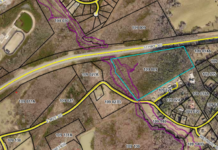
(GA Recorder) — Georgia’s bald eagles are welcoming a healthy batch of squawking little eaglets into the world, encouraging news for wildlife lovers after an outbreak of avian influenza hammered the iconic birds along the state’s coast last spring.
Georgia Department of Natural Resources survey leader Bob Sargent said he breathed a sigh of relief when it became clear that the eagles’ nesting rates were back to within the normal range.
“Last year’s exceptionally poor nesting results on the coast, as well as the lower than usual success rate in southwest Georgia, was worrisome because those areas combine for about 85% of our known eagle nests,” he said.
“The comeback of the bald eagle in Georgia is a great conservation success story, but the species is listed as threatened in the state and if high nest failures continued they could chip away at population gains,” he added. “I’m pleased to see the nest success rates rebound this year.”
The number of successful nests on the coast dropped about 30% last year, and fewer than half of the nests surveyed produced even one eagle. Bald eagles typically lay up to three eggs each year, according to the American Eagle Foundation.
Newly-hatched eaglets are completely reliant on their parents, but they grow quickly, usually taking their first flight at 10 to 14 weeks old.
This year’s survey found 232 newly-fledged eagles across the state, averaging 1.6 young per nest, slightly more than the state’s long-term average.
Nests along the coast this year produced an average of 1.5 young per nest, amounting to 89 eaglets fledged from 59 nests, compared with 50 eaglets fledged from only 34 successful nests last year.
In southwest Georgia, the birds went from producing an average of 1.5 fledglings from 62 nests to an average of 1.6 from 69 nests.
Sargent said no influenza cases have been reported in bald eagles in Georgia for more than a year, and there have been no cases in other species for about four months.
The DNR calls the recovery of the bald eagle in Georgia an environmental success story. According to the department, the state went from no known successful nests during most of the 1970s to one in 1981, 48 by the turn of the century, and more than 200 today.
The department cites a U.S. ban on the pesticide DDT in 1972, the enactment of the federal Clean Water and Clean Air Acts, protection through the Endangered Species Act, increased public awareness, restoration of local populations through release programs, and forest regrowth as factors in that recovery.







